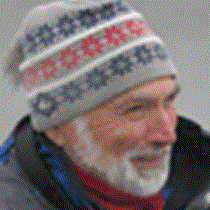Isla San Marcos
Photographers love good light and something exciting for it to shine on. Shortly after dawn, fin whales surrounded the ship, and golden water drizzled from a humpback whale’s flukes. That set the morning mood. Fin whales entertained us for hours. We often saw their bodies below the water, which gave us opportunities to take pictures just before and exactly when they surfaced. They have a white lower jaw on their right side, a marking that’s sometimes easy to see. The glassy water bent their unusual coloration into odd patterns. These fin whales frequently pushed a perfectly symmetrical bow wave before them as they rose.
North of Isla San Marcos, a tall, dagger-like fin sliced up through the water. The announcement of killer whales drew immediate attention. It was fitting that a naturalist who once worked on killer whales was in the middle of a program on how to get the best photographs of dolphins. Needless to say, he lost his audience. People spilled onto the decks in a flurry. Our ships see these charismatic animals in the gulf on average only once or twice each year, so we all were quite excited. This adult male was traveling with a female or sub-adult male. We were able to follow them for about 30 minutes. Because of the shape of the male’s dorsal fin, they could be identified as transients, those that feed on other marine mammals like whales, dolphins, and sea lions. It was a truly lucky sighting
Isla San Marcos is an island of narrow canyons winding through jagged volcanic rocks laid down during chaotic eruptions. Lahar flows are landslides of red-hot andesitic mud that rolled and tumbled down the sides of volcanoes, picking up chunks and pieces of rocks along the way. The exposures of this material in the canyon walls are a real mess. There isn’t a smooth rock in sight. The stuff looked like the inside of a giant reddish oatmeal-raisin cookie. We entered this landscape at sea level, where there are large open pockets to pass through in a kayak or swim into as a snorkelers. On land hikers wound up through the canyons, while other guests relaxed on a beach of tiny pebbles.
In the late afternoon, the crew set up a barbeque on the beach, complete with folding chairs, a fire, guitar music, star-gazing and s’mores. The sun set over the peninsula, and this Baja California landscape quietly cradled us in its beauty.
Photographers love good light and something exciting for it to shine on. Shortly after dawn, fin whales surrounded the ship, and golden water drizzled from a humpback whale’s flukes. That set the morning mood. Fin whales entertained us for hours. We often saw their bodies below the water, which gave us opportunities to take pictures just before and exactly when they surfaced. They have a white lower jaw on their right side, a marking that’s sometimes easy to see. The glassy water bent their unusual coloration into odd patterns. These fin whales frequently pushed a perfectly symmetrical bow wave before them as they rose.
North of Isla San Marcos, a tall, dagger-like fin sliced up through the water. The announcement of killer whales drew immediate attention. It was fitting that a naturalist who once worked on killer whales was in the middle of a program on how to get the best photographs of dolphins. Needless to say, he lost his audience. People spilled onto the decks in a flurry. Our ships see these charismatic animals in the gulf on average only once or twice each year, so we all were quite excited. This adult male was traveling with a female or sub-adult male. We were able to follow them for about 30 minutes. Because of the shape of the male’s dorsal fin, they could be identified as transients, those that feed on other marine mammals like whales, dolphins, and sea lions. It was a truly lucky sighting
Isla San Marcos is an island of narrow canyons winding through jagged volcanic rocks laid down during chaotic eruptions. Lahar flows are landslides of red-hot andesitic mud that rolled and tumbled down the sides of volcanoes, picking up chunks and pieces of rocks along the way. The exposures of this material in the canyon walls are a real mess. There isn’t a smooth rock in sight. The stuff looked like the inside of a giant reddish oatmeal-raisin cookie. We entered this landscape at sea level, where there are large open pockets to pass through in a kayak or swim into as a snorkelers. On land hikers wound up through the canyons, while other guests relaxed on a beach of tiny pebbles.
In the late afternoon, the crew set up a barbeque on the beach, complete with folding chairs, a fire, guitar music, star-gazing and s’mores. The sun set over the peninsula, and this Baja California landscape quietly cradled us in its beauty.



